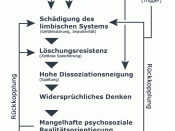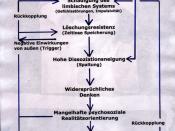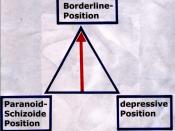Personality disorders
Where personality goes awry
A multifaceted research approach is providing more clues to the origins of personality disorders.
BY CHARLOTTE HUFF
Monitor staff
Print version: page 42
Over the years, few large-scale prospective studies have targeted the causes of personality disorders (PDs). But recently, a new body of research has begun to explore the potential influences of several factors, from genetics and parenting to peer influences, and even the randomness of life events.
Indeed, says Patricia Hoffman Judd, PhD, clinical professor of psychiatry at the University of California, San Diego, research into the origins of PDs is just beginning to take off. "I think for years people thought, 'It's just personality--you can't do anything about it,'" she explains. "There's also been moralism [that people with such disorders] are evil, that they are lazy," adds Judd, author of "A Developmental Model of Borderline Personality Disorder" (American Psychiatric Publishing, 2003).
But research is helping to turn such misconceptions around. Genetics researchers, for example, are closer to identifying some of the biological underpinnings that may influence PDs. Last year, for example, a team located--and described in Molecular Psychiatry (Vol, 8. No. 11)--a malfunctioning gene they believe may be a factor in obsessive-compulsive disorder. Other researchers are investigating genetic links to aggression, anxiety and fear--traits that could be influential in the later development of a personality disorder.
However, genetics don't work in a vacuum. Studies continue to indicate that abuse, even verbal abuse, can amplify the risk of developing a personality disorder.
For some disorders, such as antisocial PD, the evidence suggests that genetic factors play a significant role, while others, such as dependent personality disorder, appear to be more environmentally influenced, says longtime PD researcher Theodore Millon, PhD, DSc, editor of an ongoing book series, "Personality-guided Psychology" (APA).
But regardless of the specific disorder, researchers increasingly observe a back-and-forth interplay between genetic and environmental influences.
"We see a paradigm shift taking place in the field now toward a more interactionist perspective," says Jeffrey G. Johnson, PhD, associate professor of clinical psychology in Columbia University's psychiatry department. "I think the field is getting away from genetics versus environment--it's a major change."
The genetic/environmental convergence
One of the largest efforts to look at PDs, the Collaborative Longitudinal Personality Disorders Study (CLPS), is attempting to gain insight into a cross-section of the disorders' characteristics, stability and progression. The multisite study, funded by the National Institute of Mental Health until 2005, has since 1996 enrolled 668 people with the diagnoses of avoidant, borderline, obsessive-compulsive or schizotypal personality disorders. A summary of the study's aims appeared in the Journal of Personality Disorders (Vol. 14. No. 4).
Although the study is not looking directly at causes, it's collecting historical information that may one day provide some insights, says Tracie Shea, PhD, associate professor in the department of psychiatry and human behavior at Brown Medical School and one of CLPS's principal investigators. "I like to think of it as generating hypotheses that can be tested," she says.
Shea co-authored a 2002 study in the Journal of Nervous and Mental Disease (Vol. 190, No. 8) that looked at CLPS data and found an association between the severity of specific PDs and the number and type of childhood traumas. In particular, people with borderline PDs reported particularly high rates of childhood sexual trauma--55 percent detailing physically forced, unwanted sexual contact. The researchers note, however, that the type of analysis couldn't determine if the personality adaptations occurred in response to the trauma or whether the individuals' underlying character pathology predisposed them.
Among those exploring the genetic and environmental influences linking normal and abnormal personality is Robert Krueger, PhD, associate professor of psychology at the University of Minnesota. In 2002, Krueger co-authored a study in the Journal of Personality (Vol. 70, No. 5) that looked at the personality traits of 128 twin pairs who had been raised apart. The study found that the identical twins were more similar in personality traits than the fraternal twins.
Thus, although both genetics and environment contributed to the association between normal and abnormal personality, genetics appeared to play the greater role overall, Krueger says. "The predominant reason normal and abnormal personality are linked to each other is because they are linked to the same underlying genetic mechanisms," he explains.
With borderline PD, for example, ongoing research indicates that there may be a genetic base for the problems with impulsivity and aggression, says the University of California's Judd. But environmental influences are significant and can extend deep into childhood, even infancy, Judd adds.
"There is a pretty high prevalence of maltreatment by caregivers across all personality disorders," she notes. "One of the key problems appears to be neglect. Probably more of an emotional neglect--more of a lack of attention to a child's emotional needs."
Judd points to several studies by Johnson, including one published in 1999 in the Archives of General Psychiatry (Vol. 56, No. 7) that followed 639 New York state families and their children for nearly two decades. Children with documented instances of childhood abuse or neglect were more than four times as likely to develop a PD in early adulthood, according to the research.
Another study, led by Johnson and published in 2001 in Comprehensive Psychiatry (Vol. 42, No. 1), came to a similar conclusion when examining maternal verbal abuse in the same New York group of families, involving this time 793 mothers and their children. The prospective study asked mothers a variety of questions, including whether they had screamed at their children in the previous month and whether they had told their child they didn't love them or would send them away. Offspring who experienced verbal abuse in childhood--compared with those who didn't--were more than three times as likely to be diagnosed as adults with borderline, narcissistic, obsessive-compulsive and paranoid PDs.
Shea cautions, though, that at this point research into childhood neglect and abuse, albeit intriguing, has largely been suggestive because prospective studies remain limited.
"It's likely that these childhood abuse factors do play an important role," he explains. "It's hard to say what and how big that role is, more specifically."
The parent-blame problem
The role of abuse is particularly controversial among family members of people with a borderline disorder, who say they are being unfairly blamed--similar to what happened in the early days of schizophrenia research. Emphasizing maltreatment and abuse is misleading and has a devastating effect on families, says Valerie Porr, president of a New York-based nonprofit group, Treatment and Research Advancements National Association for Personality Disorder (www.tara4bpd.org/tara.html).
Porr doesn't deny that parental behavior can play a role in borderline PD. "But it's not like it's the evil mother beating her children," she says. Rather, she explains, the child's "behavior is so off the wall [that] the family's responses are off the wall."
Porr, who has a family member with borderline personality disorder, points to emerging research, including that of Harvard University-based psychologist Jerome Kagan, PhD, identifying the high sensitivity to outside stimuli of some children as significant. Family members of people with borderline PD report unusual responses even in the first months of life, Porr says, noting that, "They say, 'The light bothers them. They are sensitive to noise. Texture bothers them.'"
But Kagan, in a 2002 Dialogues in Clinical Neuroscience article (Vol. 4, No. 3), says that the role of high reactivity in infancy is far from clear-cut. It's true, he says, that highly reactive infants are more likely to develop shy, timid or anxious personalities. Still, there are puzzling questions, including the significant gap between the percentage of children--20 percent--who are highly reactive infants and the prevalence--less than 10 percent--of those who develop social phobias.
"This fact suggests that many high reactives find an adaptive niche in their society that allows them to titer unpredictable social encounters," Kagan writes.
In the end, says Johnson, the goal of research into environmental influences is not to blame, but to help parents. "We must understand what parenting behaviors are associated with greater risk to the child," he says. "When we identify those parenting behaviors, we can use them to design intervention."
The role of peers
Psychologists' findings also suggest that caregivers, teachers and even peers may play a role in PDs--both in positive as well as negative ways. Even a single strong positive relationship--say a close bond with a grandmother--can offset negative influences in a dysfunctional household.
"The child with a predisposition toward developing a personality disorder doesn't need the perfect teacher or the perfect friends to not develop the disorder," says Judith Beck, PhD, director of the Beck Institute for Cognitive Therapy and Research in suburban Philadelphia. "If the child is in an extreme environment, such as abuse or neglect, that may make the difference in terms of developing a personality disorder."
And life events can help tip the balance, Beck says. For example, a child with obsessive-compulsive tendencies who has alcoholic parents may assume the responsibility of caring for his younger siblings--a move that may amplify his propensities until he meets the diagnosis of a disorder. "It's the fit between your environment and your personality," Beck explains.
Over time, researchers will continue probing that fit and will likely identify more than a few causes even for a single personality disorder, says Millon, dean of the Florida-based Institute for Advanced Studies in Personology and Psychopathology. Narrowing down potential causes will help psychologists more quickly isolate what might be influencing a particular patient, he says.
Millon explains: "Once you identify the one cause that seems most probable and most significant, then you can design your therapy in order to unlearn what seemed most problematic for that individual."


